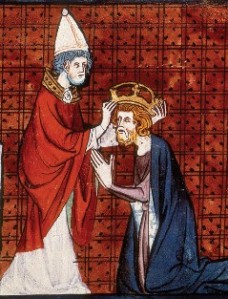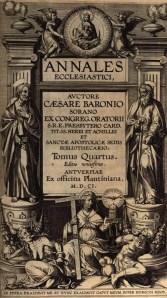“Donation of Constantine” or, how the church stole the supreme power from all sovereign kings and queens and made them “forever” puppets to the pope.
The way that kings and queens in the Christian world have been crowned by a bishop in a church, is a thirteen centuries old tradition that is in many countries is still fully alive today. Still, it is just an unfashionable way to try to maintain power and control in an old fashion hierarchical world view. This religious institution is in many ways completely obsolete in this globalised era and it is based on a hoax from the beginning when it first became known.
Constitutum domini Constantini imperatoris

Donation of Constantine (Pope Sylvester I and Constantine the Great) 13’th century, fresco, Santi Quattro Coronati, Rome
Anno Domini 751 (according to some scholars) it was brought to public attention on a piece of parchment that Constantine the Great had granted the church supremacy over all land in the Christianised world for ever, thus having the deciding power over who would rule where. This document was, and still is, called “Donation of Constantine” or simply “The Donation” and even though its validity was contested as early as 1001 by Emperor Otto III and later in 1440, when it was once more proven to be a falsification by the linguist Lorenzo Valla, its hugely controversial content was little known by the public. This was probably because Valla’s report “Declamatio”, which proved the latin in “The Donation” to be of a much later style than from the fourth century, had been stowed away and conveniently forgotten in the vast library in the Vatican. And thus could the church continue to control the minds of the public and the politics among the ruling élite, thanks to the intrinsic supremacy of the “The Donation”.

Excerpt from “The Donation”
“For, where the supremacy of priests and the head of the Christian religion has been established by a heavenly ruler, it is not just that there an earthly ruler should have jurisdiction”
Being forgotten by kings and queens and their ministers, “The Donation’s” powers still held sway for about two hundred years until the seventeenth century when it was once again brought to public attention in a report in which it was considered to be a fraudulent document. This was done by a priest working in the Vatican library who had found the report “Declamatio” by Valla.

The cardinal Caesar Baronius admitted in his great work “Annales Ecclesiastici”, published between 1588 and 1607, that “The Donation” was a fraud, and according to some scholars today it became widely accepted as such after this.

A concerned thought though. The practice that the church is the place for the coronation and the anointing ritual performed by a high priest, like a archbishop, cardinal, or even the pope himself, continued unabated into modern times. This indicates that the alleged origin of “The Donation” by the first Christian head of the Imperial Rome, Constantine the Great, still was being indoctrinated to the subjugated in all the Christendom.
The anointed king or queen were considered “mixta persona”, i.e., both priests and laymen, but not fully of either.
Subsequently “The Donation” was brought to the fore from time to time as an outright forgery well into the twentieth century, but still it is little known, and it is not taught to children today though its impact on the development of the western world can hardly be overestimated.
England is one of the few Countries still using this old ritual of coronation by the head of the church. The last time was 1953

Even if the monarchs knew of the lies behind “The Donation” or not, they immediately recognised the potential for gaining personal power, and thus the foundation for building dynasties as the prolongation of one self in the future. A way of personalising an individual apotheosis, i.e., the deification of oneself and thus making sure of an eternal life in the higher realms.
The church and the rulers used each other in a win-win arrangement and in some countries they still do.












